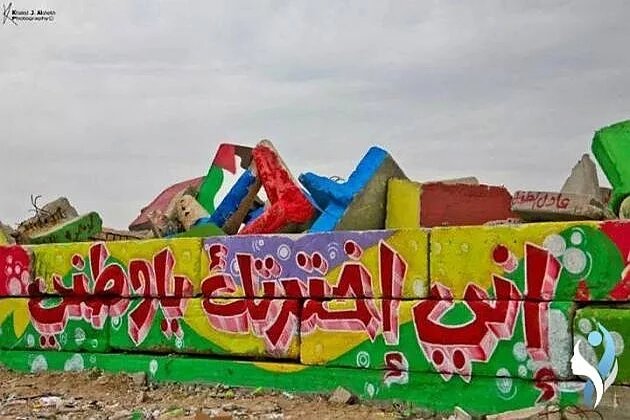
Gaza - Nawa - By Dua' Fayez
Even with the gloomy images of the Gaza Strip since the latest assault, artists’ paintbrushes did not surrender. They colored the harbor and exited their fate to express public and personal concerns. They stood up to the challenges and obstacles facing the besieged City of Gaza.
“An artist carries a strong mission for he/she is an integral part of his/her homeland and the Palestinian question”, said artist Sharif Sarhan (born 1976), describing the role his art plays to serve his national cause.
Notwithstanding the challenges Sarhan is facing in his art works, he creates many innovative ideas in a unique style of expression. He produces mainly diversified contemporary, realistic art works, mixing photography with installation and carving. He uses the alphabets of the Arabic language in his works, displayed in the Shababeek Gallery, which he co-founded with other colleagues. Sarhan says, “Fine arts suffer from scarce resources and lack of material and colors. We try to find alternatives even at heavy prices.” “Necessity has no law”, he said describing his ambitions. “I want to make this fine art internationally known to express the Palestinian question in spite of the dark days we face.”
Sharif Sarhan’s works surmounted the siege and check points. He participated in art fares outside the boundaries of his homeland, but without being personally present at the exhibitions.
Artists face many problems, but their involvement in their works and their commitment to nationalism added a special flavor to their production. Hana Hamash did not succumb to the obstacles that Sarhan mentioned. To the contrary, she became increasingly motivated to narrate with her brush the details of the life of the people; she produced different paintings telling the harsh reality she is living, to attract world’s attention.
Hamash says, “I have lived my life in my studio among my paintings, but the last war on Gaza destroyed all my belongings. I did not despair and saved the remaining paintings from underneath the rubble. I organized a fare under the title “Gaza 52”. She proceeds, “I wanted the exhibition to prove to the world that I am an artist from Gaza and nothing can dissuade me.”
Hamash alluded to many obstacles that affect artists, including insufficient awareness of fine arts and people’s inability to purchase art works because of the economic situation – not to mention the high prices of paintings. A painting may be priced at 500 US Dollar.
Hamash tried to attract artists from Europe to take part in the exhibitions she organized in Gaza. She wanted to prove to the world that Gaza was a platform for people from all nationalities to meet and produce artistic creations. She was nominated ambassador of Palestinian women, as a reward for her fare “Two Women from March”.
Artists in Gaza have not stopped at only drawing on canvass and producing paintings and murals. Through what they call “streets’ art” they aim to express the national message. Dalia Abdelrahman is a street artist. She is the mind behind the idea of coloring the harbor of Gaza. The outcome was a stunning view, attracting people from all over the Gaza Strip to visit and enjoy their summer.
We also need to talk about Iyad Sabbah, the sculptor who created numerous statues, most importantly the Unknown Soldier, Palestine Square, Gaza Downtown, and the Return in Khan Younis. He also produced a sculpture for Marty Aldamrowa in Rafah. His latest work narrated the destruction of the Shijaiya Neighborhood and the forcible displacement of its inhabitants in the last war.
In an interview with Nawa, Sabah said, “Our society suffers lack of awareness of art and its real and effective role as a tool of resistance and a means to achieve national goals.” He attributed this to lack of interest among government and state officials to provide support to artists and purchase their productions. He added, “We are deprived of the ID card “Artist” that would allow us enter all world museums for free, like other artists, not to mention the rare opportunities available to us.”
AlHasani explaind that artists in general face huge difficulties, including his association. The key problems are the absence of an artists’ syndicate or union although there are some art incubators. He explained that the absence of an umbrella to embrace artists led to a decreased interest in fine arts. He called for governmental support to fine arts and for the establishment of specialized museums to host artistic productions.
In spite of the challenges, the message and paintbrush of artists in Gaza shall continue their creative production to create permanent hope and another meaning of life.